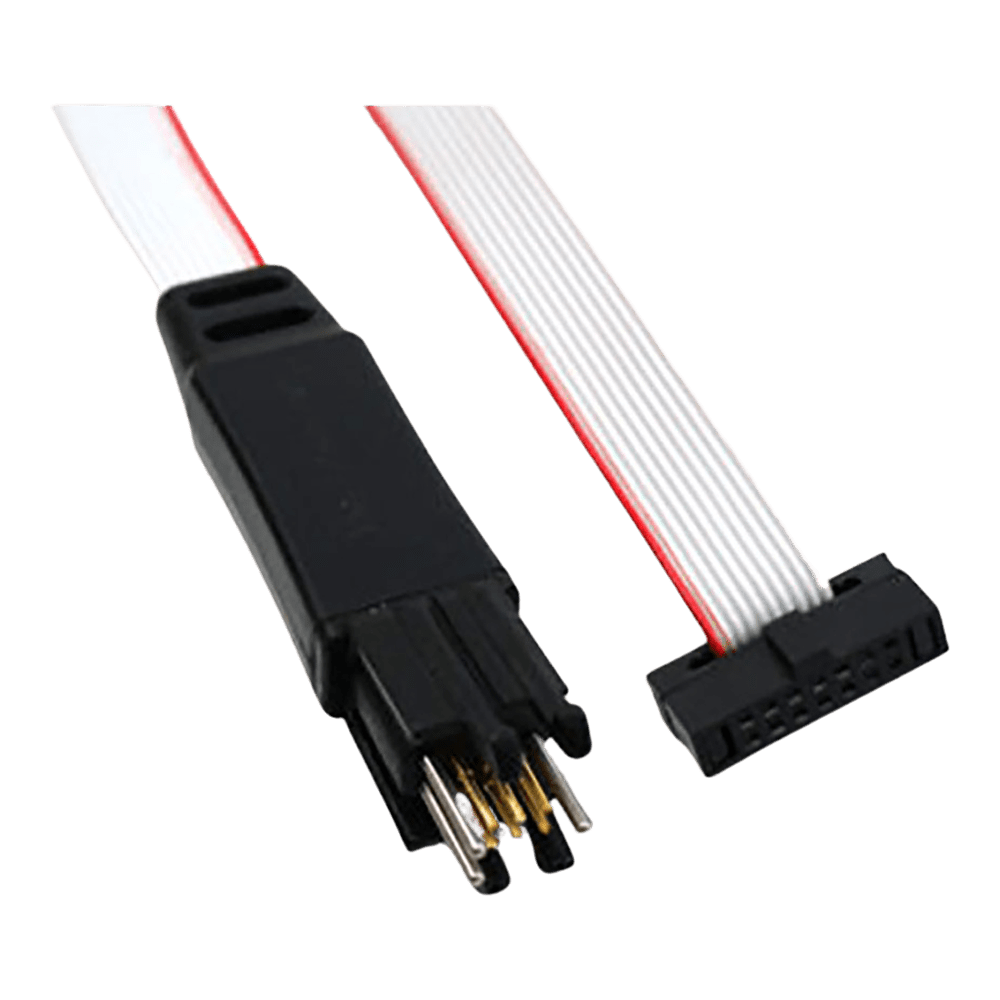

Key Features
Overview
The Tag-Connect TC2030-CTX-STDC14 is a six-pin Plug-of-Nails™ cable that connects a TC2030 Cortex SWD footprint on your PCB directly to the STDC14 (1.27 mm) header used by ST-LINK/V3 debuggers. It carries the essential SWD signals and SWO trace, allowing fast bring-up and programming without fitting a mating connector on the target board.
Choose the legged version here for hands-free use during development. If you prefer a no-legs variant for production, see the TC2030-CTX-NL-STDC14 used with a TC2030-CLIP retainer. For tools that require 10-pin or 20-pin Cortex connectors, consider the TC2050-IDC-050 family or the TC2030-CTX-20 variant.
The TC2030 footprint saves PCB space and BOM cost by eliminating the on-board header, while the spring-pin contact system offers a reliable temporary connection suitable for both lab and production use. This STDC14 cable is ideal for STM32 designs that adopt ST’s 14-pin interface and need a compact SWD access point on the target.
Former name: TC2030-CTX-ST14.
Why Engineers Choose The Tag Connect TC2030-CTX-STDC14 Cable
Space saved on target
Fast bring-up & debug
Production-ready workflow
| General Information | |
|---|---|
Part Number (SKU) |
TC2030-CTX-STDC14
|
Manufacturer |
|
| Physical and Mechanical | |
Weight |
0.1 kg
|
| Other | |
Warranty |
|
HS Code Customs Tariff code
|
|
EAN |
5055383665198
|
Frequently Asked Questions
Have a Question?
-
What’s included on the STDC14 side, and how are signals mapped to the TC2030 pads?
The STDC14 end follows the ARM Cortex 14-pin convention, carrying power-sense (VREF), ground, SWDIO/TMS, SWCLK/TCK, nRESET, SWO/TDO, and related grounds. The cable maps these to the six TC2030 contact pads, providing everything needed for standard SWD/JTAG sessions without populating a header on your board.
-
What signal integrity practices should I follow when using the TC2030-CTX-STDC14?
Keep the SWD/JTAG routes short, reference them to a solid ground plane, and avoid stubs. Use the VTARGET line to level-sense properly, and keep any series resistors/filters consistent with your MCU vendor’s recommendations. These best practices ensure clean edges and robust programming at typical SWD/JTAG speeds.
-
Is the connection reliable for manufacturing and field servicing?
Yes—this is precisely where TAG-Connect shines. The spring-pin “plug-of-nails” gives a firm, repeatable, low-resistance contact, while optional clip/retainer accessories provide hands-free operation during programming cycles. It’s well-suited to production flashing, end-of-line test, and on-site updates.
-
How does the TC2030-CTX-STDC14 compare with more expensive probe-socket and fixture systems?
Premium probe-socket systems and bespoke bed-of-nails fixtures can be costly and bulky, and they often tie you to large keep-out zones or dedicated receptacles. The TC2030-CTX-STDC14 achieves similar access for SWD/JTAG with a minimal six-pad footprint, simpler fixturing, and faster operator workflow—ideal for agile production lines and compact boards.
-
What are the unique competitive advantages of the TC2030-CTX-STDC14 versus traditional headers?
The TAG-Connect approach eliminates a fitted header, delivering a near-zero-footprint test access that saves PCB area, reduces assembly time, and removes a BOM line item. The spring-pin interface offers fast, repeatable engages for production while avoiding the wear and alignment issues of temporary through-hole headers.
-
How do I lay out the TC2030 footprint on my PCB for use with the TC2030-CTX-STDC14?
Place the standard TC2030 6-pad footprint (plus the small keep-out/retention holes if you’re using a no-legs clip system). Route the six essentials: VREF/VTARGET, GND, SWDIO/TMS, SWCLK/TCK, nRESET, SWO/TDO as required by your toolchain. Keep traces short and clean, add a nearby ground reference, and follow your MCU vendor’s SWD/JTAG layout guidance for best signal integrity.
-
Does the TC2030-CTX-STDC14 support both SWD and full JTAG?
Yes. The cable is designed for ARM Cortex SWD (2-wire) and full JTAG signal mappings delivered via the STDC14 end, then consolidated to the 6-pad TC2030 footprint on the PCB. This gives flexible access for bring-up, test and firmware programming on compact designs.
-
Which debuggers and tools are compatible with the TC2030-CTX-STDC14?
Any programmer/debug probe that presents an STDC14 (Cortex 14-pin) connector is a natural fit. That typically includes ARM Cortex SWD/JTAG tools (e.g., ST-LINK variants, J-Link adapters with STDC14, and lab fixtures using the 14-pin standard). If your probe uses a different connector, a passive adapter to STDC14 usually solves it.
-
What is the TAG-Connect TC2030-CTX-STDC14 cable and what does it do?
The TAG-Connect TC2030-CTX-STDC14 is a programming and debug cable that mates a TC2030 “plug-of-nails” footprint on your PCB to an ARM Cortex STDC14 (2×7, 1.27 mm) interface. It enables SWD/JTAG access without fitting a bulky header, saving board space and BOM cost while speeding up production and field updates.


